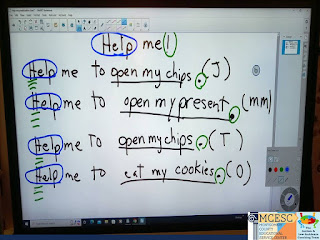Do you have a student who is hard to engage during instruction? Today's Sensational Social Skills post will focus on Joint Attention strategies to help your students engage with you so you can teach them new skills.
If you haven’t already seen our blog on the Foundation for Building Reciprocal Communication, check it out here:
The Foundation for Building Reciprocal Communication
This blog will talk about the first steps when
trying to engage with your student. Before you can expect your student to
engage with you for instruction, you need to develop motivation, regulation,
and basic self-management.
Once you have taken the time to build the
foundation, you can determine what you want to teach your student and how to
gain joint attention for the lesson. If your student struggles with joint
attention, you want to start with something easy to build momentum.
One example is a preschool student who was new to
the school environment. He struggled to engage with the adults and constantly
tried to escape the environment and throw any item placed in his space.
- The first goal
was to create a space that provided clear visual and physical boundaries.
A wide open space makes joint attention a challenge. Help to narrow the
area the student is attending to at the moment using visual screens or
strategically placed furniture. A cube chair provided physical boundaries.
 |
| Lisa Turner & Katie Mlod Mad River ECC, Mad River |
- Once this was
established, the team focused on teaching the student to take the item
placed in front of him, and instead of throwing it across the room, to
place it in a bin.
- Soon the student
learned to pull a picture off Velcro and put it in a bin. Only one picture
was on the page so it was an errorless task.
- After practicing
this basic skills in a structured environment, the student was able to
participate during the preschool morning circle using an interactive
circle time book.
 |
| Miranda Riggs Mad River ECC, Mad River |
Here are some other examples of strategies to
support joint attention during instruction:
- Use furniture to create physical boundaries
Debi Gnau
Mad River ECC, Mad River
- Use a bead box
or pillbox to provide small edible treats for task completion. The student
can match letters, numbers, or words to get a treat. These small edible reinforcers can allow quick and frequent reinforcement of those challenging or
non-preferred tasks.
 |
| Debi Gnau Mad River ECC, Mad River |
- Incorporate a fun anticipatory game to gain joint attention during instruction. For example, if using Pop-up Pirate or Jumping Jack (pictured below), the student gets to put in a sword or pull out a carrot for each small task. The anticipation of something popping unexpectedly may keep them engaged.
 |
| Beth Young Snyder Park Elementary, Springfield |
- Add personal
interest information to assignments such as worksheets, taskboxes, or other activities
 |
| Dixie Middle School, New Lebanon |
 |
| Michelle Barnhart Bell Creek Intermediate, Bellbrook-Sugarcreek |
 |
| Michelle Wade Northridge Elementary, Northridge |
 |
| Tim Cundiff Greenville High School, Greenville |
- Prior to or during instruction, gain joint attention through face-to-face physical interaction with high-fives or these classic hand games: Patty Cake, Say Say Oh Playmate, Hand Slap
Check out this article with more ideas and video examples:
Care.com 8 Easy Hand Games for Kids
- During whole
group instruction or passive listening, provide instructional visuals for
the student to manipulate.
 |
| Rose Jepson Northridge Elementary, Northridge |
 |
| Makayla Barbar Mad River ECC, Mad River |
 |
| Genevieve Harvey Walter Shade ECC, West Carrollton |
 |
| Angie Whip Northwestern Preschool, Northwestern |
 |
| Amy Beanblossom Arcanum-Butler, Arcanum |
- For non-speaking students, it is important to provide communication supports so that they have needed vocabulary readily available to engage in the activity.
 |
| Emily Ottmar Stevenson Elementary, Mad River |
- During
instruction, use a pointer or light to direct the learner’s gaze to the
target.
Try some of these strategies with your hard to
engage student. It may take multiple tries before a strategy becomes effective.
Keep in mind that what works for one learner may not work for all. And finally,
always remember your foundation for joint attention: regulation, motivation,
and basic self-management.































